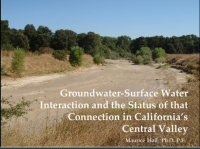 6.12.2015:
6.12.2015:
From this year’s California Water Policy Seminar Series, presented by the UC Davis School of Law and the Center for Watershed Sciences, this article explains in detail how excessive groundwater pumping results in reduced streamflow in the tributaries and main stem of the Sacramento Valley River system.
Back in the 1950s and ’60s, the Sacramento River and its tributaries were probably gaining about a million acre-feet per year on average from the groundwater. As pumping progressed through the years, the groundwater levels were drawn down… “Overall, it reduced the amount of water that was flowing from the groundwater into the Sacramento River tributaries, to the point where around 2009 … there was a million acre feet per year on average, less water in the river than there would have been without groundwater pumping.”
Mr. Hall said they then did a model run, keeping the same rates of pumping, reservoir operations and other conditions the same as today. “The impact from the pumping that is occurring today hasn’t reached the river yet,” he said. “So in 10 – 20 years from now, there’s going to be even less flow in the Sacramento River than there would have been because of the pumping that’s happening today. It takes a while for the impacts to move through the aquifer. And that’s the case here; the impacts from today’s pumping haven’t even shown up yet in the river.”
Increased pumping is going to take years and perhaps even decades to show up at the river.
Click link to view:
